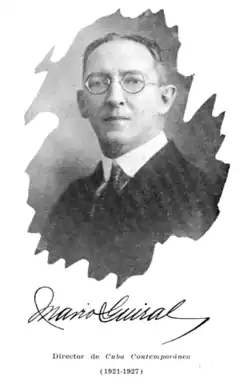Cuba Contemporánea
_(IA_cubacontemporane09vela).pdf.jpg)


Cuba Contemporánea was a Cuban magazine published monthly in Havana from January 1913 to August 1927, and has been described as "the first great magazine of Cuban thought in the 20th century,"[1][2] achieving significant international prestige despite facing censorship and opposition within the island. It was founded and written by prominent members of the "first generation of the Cuban Republic" – a group of independent and liberal intellectuals who emerged following Cuba's independence in 1902.[1] The magazine sought to emulate earlier publications such as Revista de Cuba and Revista Cubana.[1] The magazine's mission was to provide an open platform for modern thought, particularly encouraging Cuban literary and intellectual production, bibliographic studies, and historical analysis – especially regarding Cuba, the Spanish-speaking world, and the broader Americas.[1] Antonio Checa Godoy described it as the most significant and enduring publication of its time.[1] Each issue varied in length, typically between 100 and 200 pages, and every four issues formed a volume, complete with indexes of topics and authors.[1] The full collection comprised 44 volumes, with the final issue published between June and August 1927.[1][3]
History
Cuba Contemporánea was conceived in 1909 by a group of intellectuals at the Ateneo de La Habana, initially as a magazine focused on urban aesthetics.[4] The journalists present at that original meeting were Julio Villoldo, Cristino F. Cowan, Fermín Peraza Sarusa, and Luis Marino Pérez.[4] By 1911, the vision had expanded to include broader intellectual and cultural discussions.[4] The final plan was formalized in August 1912, and the magazine was officially launched on January 1, 1913.[4] The founding members – Carlos de Velasco, Julio Villoldo, José Sixto de Sola, Mario Guiral Moreno, Ricardo Sarabasa, and Max Henríquez Ureña – funded the publication themselves, maintaining financial independence from external influences.[4]
During its early years, the magazine quickly established itself as a major platform for Cuban and Latin American intellectual discourse. It covered a wide range of topics, including history, politics, sociology, literature, and international affairs.[4] The death of co-founder José Sixto de Sola in 1916 was a major blow, but the magazine continued to grow, strengthening its editorial team with new contributors.[4] In 1918, the Sociedad Editorial Cuba Contemporánea was created to ensure the magazine's financial sustainability. That same year, the group purchased the El Siglo XX printing press for $30,000, securing full control over its production.[4]
Between 1919 and 1923, the magazine reached its peak in influence.[4] A new generation of intellectuals, including Dulce María Borrero, Francisco G. del Valle, and Enrique Gay Calbó, joined the editorial team.[4] In 1920, founding director Carlos de Velasco left for a diplomatic post, and Mario Guiral Moreno took over leadership. By 1923, historian Emilio Roig de Leuchsenring had joined the magazine, adding to its nationalist discourse.[4] The publication gained praise from leading Cuban intellectuals, including Enrique José Varona, who saw it as a major force in shaping Cuban thought.[4]
Velasco died in 1923, striking another blow to the magazine.[5]
From 1923 onward, Cuba Contemporánea began to experience difficulties. Internal disagreements led to the resignations of key figures such as Juan C. Zamora and Ernesto Dihigo.[4] The magazine saw temporary leadership changes in 1925 and 1926, with Julio Villoldo serving as interim director at various points.[4] Financial struggles, along with a changing political and cultural landscape, made it increasingly difficult to sustain operations. By August 1927, after 44 published volumes, the magazine was forced to suspend publication indefinitely.[4]
Despite its closure, Cuba Contemporánea left a lasting legacy as one of Cuba's most important intellectual publications. It provided a platform for both emerging and established thinkers, resisting external pressures and maintaining a high standard of discourse.[4] Historian Emilio Roig de Leuchsenring later described it as a “herald of nationalism and a defender of liberty and justice,” underscoring its role in shaping Cuban intellectual and political culture.[4]
Online archives
References
- ^ a b c d e f g "Cuba Contemporánea". hemerotecadigital.bne.es. Retrieved March 21, 2025.
- ^ "Black Atlantic: 12 Cuba Social Magazine Insights". University of Georgia. Retrieved March 21, 2025.
- ^ "CINCUENTENARIO PERIODÍSTICO DE ENRIQUE GAY-CALBÓ" (PDF). repositoriodigital.ohc.cu. CUADERNOS DE HISTORIA HABANERA. OFICINA DEL HISTORIADOR DE LA CIUDAD DE LA HABANA. 1957.
- ^ a b c d e f g h i j k l m n o p q Sarausa, Fermín Peraza (1940). Índice de Cuba contemporánea (in Spanish). Municipio de la Habana.
- ^ "Periodicals – Cuban Genealogy Club of Miami, Fl., Inc". Retrieved 2025-03-22.